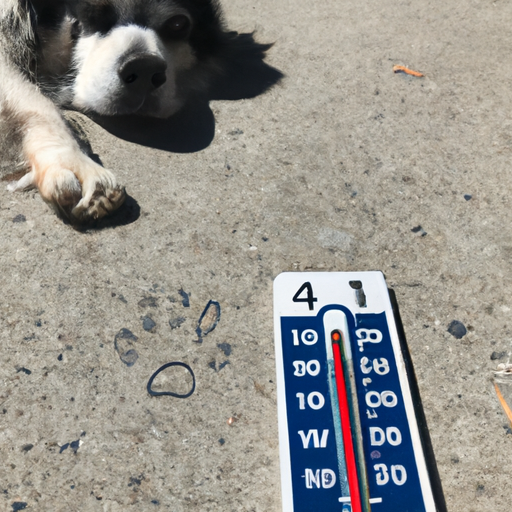Understanding the Heat Risk to Our Four-Legged Friends
Firstly, let’s establish the issue. The temperature of the pavement can often be much hotter than you might expect. On a typical summer day, when the air temperature is 77°F (25°C), the temperature of asphalt in the direct sun can heat up to 125°F (51°C). At this temperature, skin destruction can occur in just 60 seconds. This is particularly concerning for our fur-coated friends who walk bare-pawed on the pavement.
You might think, “It’s not that hot outside, the pavement can’t be too bad.” Unfortunately, that’s not the case. Even on a relatively mild day, the pavement can still reach dangerous temperatures. For example, when the air temperature is 86°F (30°C), the asphalt can reach 135°F (57°C).
Here’s a quick reference table to illustrate this point:
| Air Temperature (°F) | Asphalt Temperature (°F) |
|---|---|
| 77 | 125 |
| 86 | 135 |
| 87 | 143 |
| 88 | 147 |
Ensuring Your Dog’s Safety in the Heat
Now that you understand the potential risk, it’s crucial to take steps to protect your pet. Here are some simple yet effective measures you can take:
-
Walk Your Dog Early in the Morning or Late in the Evening: The pavement is typically coolest at these times. Avoid afternoon walks when the sun has been baking the pavement all day.
-
Test the Pavement: Before you embark on your walk, place the back of your hand on the pavement. If it’s too hot for you to keep your hand on for five seconds, it’s too hot for your dog’s paws.
-
Invest in Dog Booties or Paw Wax: These products can provide a protective barrier between your dog’s paws and the hot pavement. Just be sure to acclimate your dog to them gradually.
Recognizing the Signs of Paw Burn
Despite your best efforts, paw burn can still occur. Here’s what you need to watch out for:
- Limping or attempting to pick up their feet off the ground
- Darker color pads
- Blisters or redness
- Visible signs of pain or discomfort when walking
If you notice any of these signs, it’s important to get your dog off the hot pavement immediately and seek veterinary care.
Caring for a Dog with Burned Paws
If your dog does end up with burned paws, it’s important to act quickly. Here’s what you can do:
- Rinse the paws with cool, not cold, water.
- Apply a soothing aloe-based gel or paw balm.
- Wrap the paws lightly with a bandage or cloth to prevent further damage.
- Seek veterinary care as soon as possible.
Frequently Asked Questions
Q: How can I tell if the pavement is too hot for my dog?
A: Use the five-second rule. Place the back of your hand on the pavement. If it’s too hot for you to keep it there for five seconds, it’s too hot for your dog’s paws.
Q: My dog has burned paws, what should I do?
A: Rinse the paws with cool water, apply a soothing gel, wrap the paws lightly, and seek veterinary care immediately.
Q: Can I walk my dog on grass instead of pavement?
A: Yes, grass is typically much cooler than pavement and can be a safer option in the heat. However, keep an eye out for signs of distress as grass can also get hot.
In conclusion, the summertime heat can make the pavement dangerously hot for our canine companions. It’s our responsibility as caregivers to ensure their safety and comfort during these warm months. Keep these guidelines in mind, and you and your furry friend can safely enjoy your summer walks.



